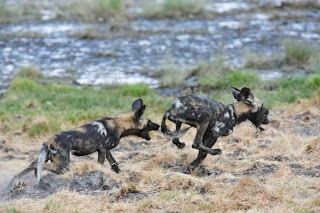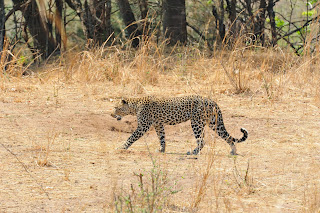So, here we are at Rivertrees, Arusha. Our final port of call so aside from a trip to the National Park to view Kilimanjaro we are almost done.
Our arrival in Tanzania was quite spectacular. The area was very lush and green with almost tropical vegetation. Quite a contrast to Malawi, and the road from the border ran along a high ridge with deep valleys dropping to both sides with distant mountain views on each side. Our first impression was that Tanzania seemed more developed than Zambia and Malawi but not as overcrowded.
We made a couple of stops at camp sites to break the long journey from the border to the Ruaha National Park, our first real destination. The second of these camp sites was a bit of a gem catering for the overlander market and run by a formidable Ex-pat English woman called Nicola. It was spotlessly clean and very efficient, quite a change really. There we met two Dutch overlanders with whom we shared a fireside chat and cuppa. They told us of the bandit dressed in army uniform who had stopped tourists on the road into Ruaha and that a shot had been fired. Nicola told us that it was becoming a problem and had happened twice in three weeks. So it was with some trepidation we set of along the rough and lonely road to Ruaha the following morning. Sue held binoculars so we could check out any likely looking types standing by the road. As it happened the worst thing about the journey was the heavily corrugated road that shook us to pieces. As one guy said, its like a reverse assembly line, your vehicle ends up in pieces.
Ruaha wasn't the most wildlife intensive park but interesting nonetheless and we did find a pride of lions on our way to the camp. In fact they were just 200 meters from the lodge along the river bank so no surprise when we heard them roaring in the night. The park did have a lot of giraffes which were nice to see again as they are not present in Malawi at all.
Our arrival in Tanzania was quite spectacular. The area was very lush and green with almost tropical vegetation. Quite a contrast to Malawi, and the road from the border ran along a high ridge with deep valleys dropping to both sides with distant mountain views on each side. Our first impression was that Tanzania seemed more developed than Zambia and Malawi but not as overcrowded.
We made a couple of stops at camp sites to break the long journey from the border to the Ruaha National Park, our first real destination. The second of these camp sites was a bit of a gem catering for the overlander market and run by a formidable Ex-pat English woman called Nicola. It was spotlessly clean and very efficient, quite a change really. There we met two Dutch overlanders with whom we shared a fireside chat and cuppa. They told us of the bandit dressed in army uniform who had stopped tourists on the road into Ruaha and that a shot had been fired. Nicola told us that it was becoming a problem and had happened twice in three weeks. So it was with some trepidation we set of along the rough and lonely road to Ruaha the following morning. Sue held binoculars so we could check out any likely looking types standing by the road. As it happened the worst thing about the journey was the heavily corrugated road that shook us to pieces. As one guy said, its like a reverse assembly line, your vehicle ends up in pieces.
Ruaha wasn't the most wildlife intensive park but interesting nonetheless and we did find a pride of lions on our way to the camp. In fact they were just 200 meters from the lodge along the river bank so no surprise when we heard them roaring in the night. The park did have a lot of giraffes which were nice to see again as they are not present in Malawi at all.
This guy knows how to pose for a photo.
We left Ruaha on the same route with a similar degree of caution and made it to Iringa where we camped for the night. Then followed 2 days of long driving, over 200 miles a day with a stop in Dodoma, the capital, on the way. The second day was really interesting as we were in the Masai Steppe and from here there have been Maasai in their colourful clothing herding their stock all along the route. The road from Dodoma was a real treat, no attempt to improve it so it was very rough but through countless villages with glimpses of everyday life and wonderful mountain views.
Maasai cattle herder.
Then we reached Tarangire which is rich in wildlife and the animals are easier to spot as the landscape is more open savannah. We had been booked into a special campsite for 2 nights there which basically means that you spend the night in an open space with no facilities miles from anyone apart from the animals. Once it is dark (at 7pm) you sit by the fire for about an hour and then go into the tent, not daring to leave until daylight due to the number of predators. I did sleep but lightly and intermittently mainly fearing a herd of elephants foraging around us although to be fair they had seemed calmer here than in previous countries. I also remembered those wildlife programmes where lions jump on the car bonnet. Luckily it was only jackals and general scuffling from some nocturnal beasts that we heard, well apart from some load roaring in the middle distance. Being on Frazer Island in Australia with the dingoes was a piece of cake compared to this. I was not too sorry when it started to rain the following afternoon and as it was our last night of camping and we didn't want to pack a wet tent etc. we booked into a lodge, getting a great last minute rate.
Our wilderness camp site inside Tarangire
A reminder we did not have the place to ourselves.
Then onto to Ngorongoro crater which is absolutely brilliant. An enchanting place and again the wildlife is brilliant and so easy to spot, not only due to the openness of the landscape but the animals are so unafraid of cars they act as though you are not there. Very few people drive independently into the crater so when you do it is a curiosity to the other tourists as well as the game vehicle driver/guide. When a woman drives the curiosity increases and with some malevolence from some of the driver/guides too.
The hotel we stayed in there was a time capsule. Built in 1969 the interior design was all perfect 1960's harmony and it had at the time been built with no expense spared. It is a gem and every bedroom overlooks the crater. We couldn't understand how it wasn't full as opposed to nearly empty as it not only has the best views of any hotel being the first to be built on the rim of the crater, it is also the cheapest.
Arrival at Ngorongoro Crater
Ready for the descent road into the crater,
We felt sad to be leaving the crater as we both loved it and it felt like the end of our trip. We journeyed to Arusha where we have spent today in their national park enjoying the flamingoes and seeing different monkeys, the blue and the colobus. Unfortunately Kilimanjaro was invisible due to the low clouds as the rainy season is now under way. Overlanders or self-drivers seem to be a bit of a novelty here so we have been upgraded at our final lodge to a fabulous suite of rooms that Prince Charles used when he visited Arusha.
We have been very lucky with the weather overall though and with everything really, the only problems we have had apart from angry elephants have been minor ones with the car. Well I say minor ones, it did break down in the crater again as the relay is all but shot. Fortunately Colin could repair it enough for the long ascent and the next part of the journey.
One of the things I will really miss about Africa, and there are several, are the vast array of colourful birds but the car journeys covered in dust I won't miss. Overall though it has been a brilliant trip, thoroughly enjoyed by both of us and we feel very lucky to have had such a great experience.










































